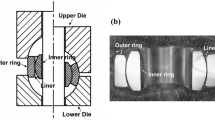Abstract
This paper concerns the development of oil-filled, heat-resistant aromatic polyamide Phenilon C-2-based composites with high physicomechanical characteristics, an advantage that can withstand loads of up to 25 MPa and operating temperatures of up to 250°C in friction units. When producing oil-filled, Phenilon C-2-based nanocomposites with 300–320°C molding temperature, the choice of oils is limited and depends on their ability to maintain lubricating properties at high temperatures. The physicomechanical and tribological test results using different friction machines prove oil filling’s high efficiency in creating a stable lubricating film on a tribocontact and in improving the tribological properties of polymer composites. Research results helped outline the range of the most promising hybrid fillers for Phenilon C-2-based polymer composites and lubricants for oil filling, which contribute to the formation of a long-lasting lubricating film on a tribocontact. The combination of the experimental studies and a scientifically based approach to predicting the properties of polymer nanocomposites makes possible expedited development of new materials with high target characteristics. The technology of the production and use of these oil-filled polymers refers to nontraditional areas of plastic processing; however, the world statistics of production and consumption of polymeric friction and wear inhibitors shows that these materials are one of the most promising ways to reduce operating losses.





Similar content being viewed by others
REFERENCES
Twist, C.P., Seyam, A.M., Chen, C., Kim, M.-G., Weberski M.P., Jr., Ren, N., Marks, T., Chung, Y.W., and Wang, Q.J., Molecularly-engineered lubricants: synthesis, activation, and tribological characterization of silver complexes as lubricant additives, Adv. Eng. Mater., 2012, vol. 14, pp. 101–105.
Chang, L. and Friedrich, K., Enhancement effect of nanoparticles on the sliding wear of short fiber-reinforced polymer composites: a critical discussion of wear mechanisms, Tribol. Int., 2010, vol. 43, no. 12, pp. 2355–2364.
Kuznetsov, V.A., Hybrid composite materials based on chemical fibers and filaments with an organic matrix, Itogi Nauki Tekh., Ser.: Khim. Tekhnol. Vysokomol. Soedin., 1986, no. 21, pp. 199–249.
Kolesnikov, V.I., Ivanochkin, P.G., Myasnikova, N.A., Danilchenko, S.A., and Myasnikov, Ph.V., The influence of surface nanostructures on the formation mechanism of the anti-friction layer at tribocontact, Int. Conf. on Physics and Mechanics of New Materials and Their Applications, New York: Nova Science, 2017, pp. 121–131.
Derlugyan, P.D., Shcherbakov, I.N., Ivanov, V.V., Loginov, V.T., Trofimov, G.E., and Derlugyan, F.P., Khimicheskoe nanokonstruirovanie kompozitsionnykh materialov i pokrytii s antifriktsionnymi svoistvami: monografiya (Chemical Nanodesign of Composites and Coatings with Antifriction Properties: Monograph), Rostov-on-Don: Yuzhno-Ross. Gos. Politekh. Univ., 2011.
Derlugyan, P.D. and Levintsev, V.A., Production of self-lubricating composite maslyanit-GM by chemical design, Izv. Sev.-Kavk. Nauchn. Tsentra Vyssh. Shk., Tekh. Nauki, 2014, no. 2, pp. 9–15.
Polimery v uzlakh treniya mahsin i mekhanizmov. Spravochnik (Polymers in Friction Knots of Machines and Mechanisms), Chichinadze, A.V., Ed., Moscow: Mashinostroenie, 1980.
Lazarev, A.N., Mirgorodskii, A.P., and Ignat’ev, I.K., Kolebatel’nye spektry slozhnykh oksidov (Oscillatory Spectra of Complex Oxides), Moscow: Nauka, 1989.
Ivanochkin, P.G., Novikov, E.S., and Danilchenko, S.A., Estimation of tribological and physical-mechanical properties of oil-filled nanocomposites, Trudy mezhdunarodnoi nauchno-tekhnicheskoi konferentsii “Novye materialy i tekhnologii v mashinostroenii” (Proc. Int. Sci.-Tech. Conf. “New Materials and Technologies in Machine Engineering”), Bryansk: Bryansk. Gos. Inzh.-Tekhnol. Univ., 2017, no. 26, pp. 29–34.
Ivanochkin, P.G., Danilchenko, S.A., Novikov, E.S., and Manturov, D.S., Study of physical, mechanical and tribological properties of nanocomposites based on oil-filled polymers, 2017 Int. Conf. on “Physics and Mechanics of New Materials and Their Applications” (PHENMA 2017), Jabalpur, India, October 14–16, 2017, Abstracts of Papers, Chennai: Indian Inst. Inf. Technol., Des. Manuf., 2017, p. 90.
ACKNOWLEDGMENTS
This work was supported by the Russian Science Foundation, project no. 14-29-00116.
Author information
Authors and Affiliations
Corresponding author
Additional information
Translated by E. Petrova
About this article
Cite this article
Kolesnikov, V.I., Myasnikova, N.A., Myasnikov, P.V. et al. Tribological and Physicomechanical Properties of Oil-Filled, Phenilon-Based Composites. J. Frict. Wear 39, 365–370 (2018). https://doi.org/10.3103/S1068366618050082
Received:
Published:
Issue Date:
DOI: https://doi.org/10.3103/S1068366618050082




